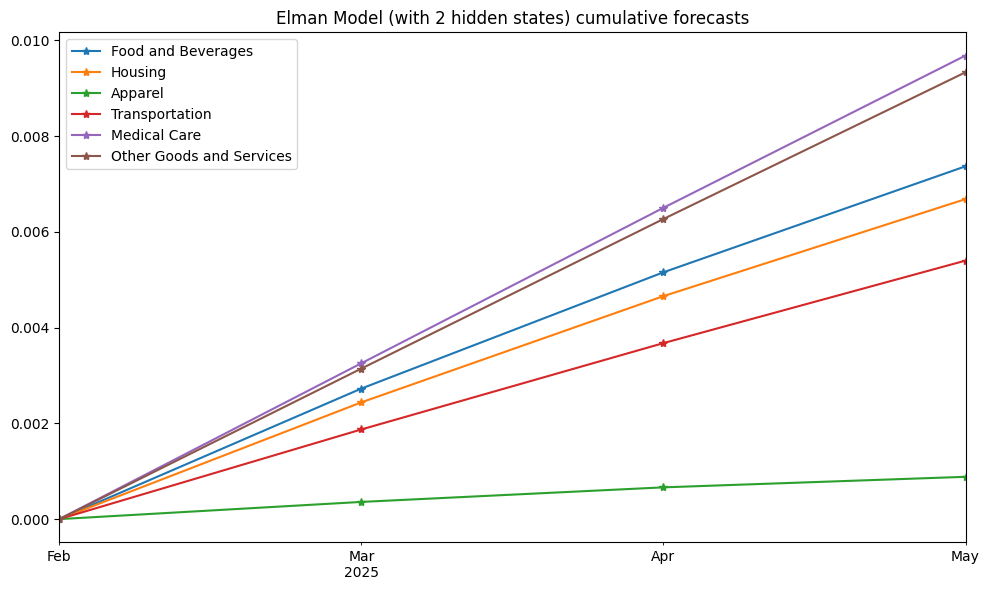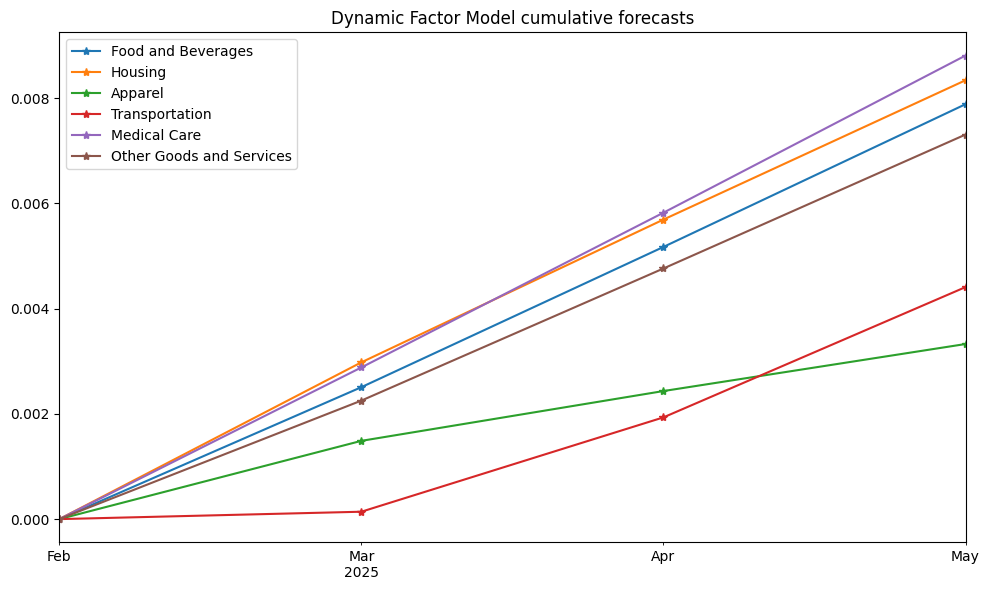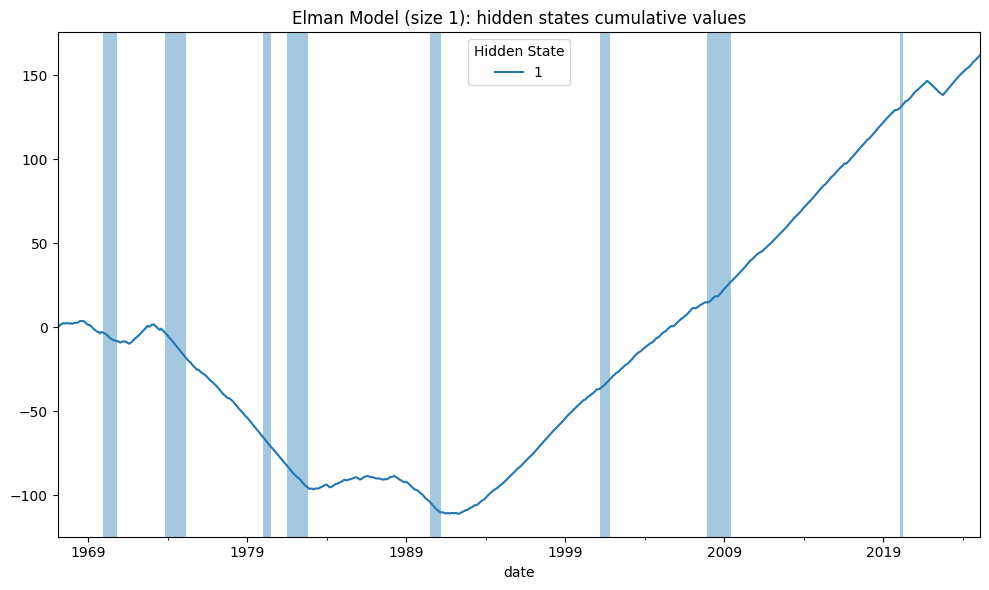Recurrent Neural Networks#
History doesn’t repeat itself, but it often rhymes - Mark Twain
We analyze the application of Recurrent Neural Networks (RNNs) for forecasting multivariate time series data, focusing on U.S. Consumer Price Index (CPI) components. RNN models are trained under different configurations to compare their predictive performance and investigate the behavior of their hidden states. Additionally, we examine how the temporal patterns learned by RNNs relate to the latent factors uncovered by Dynamic Factor Models (DFMs), a classical econometric approach for modeling co-movements in time series data.
# By: Terence Lim, 2020-2025 (terence-lim.github.io)
import numpy as np
import pandas as pd
from pandas import DataFrame, Series
import matplotlib.pyplot as plt
import gc
import statsmodels.api as sm
import torch
import torch.nn as nn
import torchinfo
from sklearn.preprocessing import StandardScaler
from sklearn.metrics import mean_squared_error
from tqdm import tqdm
from finds.structured import BusDay
from finds.readers import Alfred
from secret import credentials
import warnings
# %matplotlib qt
VERBOSE = 0
if not VERBOSE: # Suppress FutureWarning messages
warnings.simplefilter(action='ignore', category=FutureWarning)
device = torch.device("cuda" if torch.cuda.is_available() else "cpu")
# train-test split date
split_date = '2021-12-01'
Sequence modeling#
Recurrent Neural Networks (RNNs) are powerful models for learning from sequential data, enabling tasks such as language modeling, translation, and time series forecasting by maintaining a memory of past inpformation. Unlike feedforward networks, RNNs process sequences one step at a time, using a hidden state that carries information across time steps to capture temporal dependencies. Variants like Elman and Jordan networks provide basic feedback mechanisms, while more advanced models such as LSTMs and GRUs address training challenges like vanishing gradients. However, RNNs remain inherently sequential, making them slower to train and less parallelizable compared to modern architectures like convolutional or transformer models.
Recurrent units#
RNNs retain temporal information through recurrent connections, applying the same computation repeatedly at each time step while maintaining a hidden state (memory). The hidden state \(h_t\) is updated based on the current input \(x_t\) and the previous hidden state \(h_{t-1}\):
where the initial hidden state \(h_0\) is typically initialized to zero, \(\theta_h\) are learnable parameters, and \(f_h\) is the recurrent function (e.g., tanh, ReLU, GRU, LSTM).
Training RNNs is more complex than training feedforward neural networks due to dependencies across time steps.
RNNs are unfolded through time, applying the same parameters (shared weights) at each step, and trained using standard backpropogation, known as Backpropagation Through Time (BPTT) when applied over multiple time steps. This makes training computationally expensive, and prone to vanishing gradients (gradients shrink) and exploding gradients (gradients blow up), which respectively limit the model’s ability to learn long-range dependencies and cause unstable updates.
LSTM networks#
Long Short-Term Memory (LSTM) networks mitigate the vanishing gradient problem by introducing a cell state and multiple gating mechanisms that regulate information flow. Key components include:
Cell state \(c_t\): A “memory” that runs through the network, modified by gates.
Hidden state \(h_t\): Output of the LSTM at each time step.
Input \(x_t\): Current input at time \(t\).
Previous state \(h_{t-1}, c_{t-1}\): From the last time step.
Gates:
Forget gate \(f_t\): Decides what information to discard from the cell state.
Input gate \(i_t\): Controls how much new information flows into the cell state.
Output gate \(o_t\): Determines what part of the cell state should be output as \(h_t\).
A cell update combines the past cell state and new input to update \(c_t\). The \(h_t\) output is updated from \(c_t\) and previous its previous state \(h_{t-1}\).
GRU networks#
Gated Recurrent Unit (GRU) networks are a simplified version of LSTMs that combine cell state and hidden state into a single vector, using fewer gates:
Update gate (similar to combined forget/input gate): Controls what part of the past state to keep.
Reset gate: Controls how to combine new input with the previous memory.
Single hidden state \(h_t\): Serves as both memory and output.
GRUs are computationally more efficient than LSTM, and perform comparably on many tasks.
Elman network#
An Elman network is a basic RNN where recurrence occurs within the hidden layer:
Multiple Elman layers can be stacked to capture longer-term dependencies and more complex temporal patterns. For every element in the input sequence, each layer computes the following function:
where
\(h_t\) is the hidden state at time \(t\),
\(x_t\) is the input at time \(t\),
\(h_{t−1}\) is the hidden state of the previous layer at time \(t-1\) or the initial hidden state at time 0, and
\(b\)’s and \(W\)’s are the learnable bias and weights
We implement a single-layer Elman RNN using PyTorch’s standard RNN module to process sequential data, with Dropout regularization to reduce overfitting.
class Elman(nn.Module):
def __init__(self, n_features, hidden_size, dropout, num_layers=1):
super().__init__()
self.hidden_size = hidden_size
self.output_size = n_features
self.num_layers = num_layers
self.dropout = nn.Dropout(dropout)
self.rnn = nn.RNN(input_size=n_features,
hidden_size=hidden_size,
num_layers=num_layers)
self.o2o = nn.Linear(hidden_size, n_features)
def forward(self, x, hidden):
x = self.dropout(x) # drop out input layer
output, hidden = self.rnn(x, hidden)
output = self.o2o(output[-1:, :])
return output, hidden
def init_hidden(self):
return torch.zeros(self.num_layers, self.hidden_size)
Data preparation#
CPI time series data for multiple components (e.g., food, housing) are collected from FRED. The data are log-transformed and differenced to ensure stationarity, then standardized (using StandardScaler) to have mean 0 and variance 1. The time series data are split into training followed by testing sets using a defined cutoff date.
# Max number of hidden states (RNN) or factors (Dynamic Model)
K = 2
# number of out-of-sample forecasts to predict
nforecast = 3
# Load time series from FRED
alf = Alfred(api_key=credentials['fred']['api_key'], verbose=VERBOSE)
vspans = alf.date_spans('USREC') # recession periods
# CPI for U.S. City Average: Monthly, Seasonally Adjusted
# https://fred.stlouisfed.org/release/tables?rid=10&eid=34483
# 'CUSR0000SEEA'
series_ids = ['CPIFABSL', 'CPIHOSSL', 'CPIAPPSL', 'CPITRNSL', 'CPIMEDSL', 'CPIOGSSL']
df = pd.concat([alf(s, log=1, diff=1) for s in series_ids], axis=1)\
.dropna()\
.sort_index()
df.index = BusDay.to_datetime(df.index)
df.index.freq = 'ME' # set index to datetime type and freq = 'M'
names = [s[s.find(':')+2:s.find(' in ')] for s in alf.header(series_ids)]
names
['Food and Beverages',
'Housing',
'Apparel',
'Transportation',
'Medical Care',
'Other Goods and Services']
# Standardize the data data
scaler = StandardScaler().fit(df)
scaled_data = DataFrame(scaler.transform(df), columns=names, index=df.index)
scaled_data
| Food and Beverages | Housing | Apparel | Transportation | Medical Care | Other Goods and Services | |
|---|---|---|---|---|---|---|
| date | ||||||
| 1967-02-28 | -1.520716 | -1.129800 | 0.533990 | 0.266586 | -0.248585 | -1.017195 |
| 1967-03-31 | -0.805655 | -1.129800 | 0.124553 | -0.267488 | -0.253160 | -0.284868 |
| 1967-04-30 | -1.522780 | -0.063784 | 0.529140 | 0.263339 | 0.988995 | -1.017195 |
| 1967-05-31 | -0.805655 | -0.067262 | 0.122142 | -0.003280 | -0.266687 | -0.286982 |
| 1967-06-30 | 1.339539 | -1.129800 | 0.524347 | -0.267488 | 0.962232 | -0.289083 |
| ... | ... | ... | ... | ... | ... | ... |
| 2024-10-31 | -0.252031 | 0.063171 | -2.110286 | -0.203592 | -0.692758 | -0.172972 |
| 2024-11-30 | -0.053379 | -0.037266 | -0.114479 | 0.027062 | -0.702581 | 0.085335 |
| 2024-12-31 | -0.180743 | -0.209529 | -0.015224 | 0.767819 | -1.058184 | -1.113129 |
| 2025-01-31 | 0.090331 | -0.037301 | -3.137367 | 0.794814 | -0.701262 | -1.822241 |
| 2025-02-28 | -0.350673 | 0.133190 | 0.934107 | -0.605692 | -0.563596 | 0.499572 |
697 rows × 6 columns
# Create input data for RNN
ntrain = sum(scaled_data.index < split_date)
ntest = len(scaled_data.index) - ntrain - 1
n_features = scaled_data.shape[1]
data = scaled_data.values
Training#
RNN models with different hidden sizes (\(K = 1, 2\)) are trained using an Adam optimizer and a StepLR learning rate scheduler, which reduces the learning rate during training for better convergence.
# Train model
num_layers = 1
dropout = 0.0
lr = 0.01 # starting learning rate
step_size = 100 # number of steps per learning rate
num_lr = 3 # number of learning rate periods
num_epochs = step_size * num_lr
train_loss = {}
hidden_states = {}
for hidden_size in range(1, K+1):
torch.manual_seed(0)
model = Elman(n_features=n_features,
hidden_size=hidden_size,
dropout=dropout,
num_layers=num_layers).to(device)
print(model)
torchinfo.summary(model)
# Set optimizer and learning rate scheduler
optimizer = torch.optim.Adam(model.parameters(), lr=lr)
scheduler = torch.optim.lr_scheduler.StepLR(optimizer,
step_size=step_size,
gamma=0.1)
loss_function = nn.MSELoss()
train_loss[hidden_size] = []
for epoch in tqdm(range(num_epochs)): # Run training loop per epoch
model.train()
model.zero_grad()
hidden = model.init_hidden().to(device)
loss = torch.FloatTensor([0]).to(device)
for i in range(ntrain):
x = torch.FloatTensor(data[[i], :]).to(device)
y = torch.FloatTensor(data[[i+1], :]).to(device)
output, hidden = model(x, hidden)
l = loss_function(output, y)
loss += l
loss.backward()
optimizer.step()
scheduler.step()
model.eval()
train_loss[hidden_size].append(float(loss)/ntrain)
#if VERBOSE:
# print(epoch, train_loss[hidden_size][-1], scheduler.get_last_lr())
# collect predictions and hidden states, and compute mse
with torch.no_grad(): # reduce memory consumption for eval
loss_function = nn.MSELoss()
hidden = model.init_hidden().to(device)
hidden_states[hidden_size] = [hidden.cpu().numpy().flatten()]
y_pred = [np.zeros(n_features)]
for i in range(ntrain + ntest):
x = torch.FloatTensor(data[[i], :]).to(device)
y = torch.FloatTensor(data[[i+1], :]).to(device)
output, hidden = model(x, hidden)
hidden_states[hidden_size].append(hidden.cpu().numpy().flatten())
y_pred.append(output.cpu().numpy().flatten())
# k-step ahead forecast at end of period
for i in range(nforecast):
x = y
y, hidden = model(x, hidden)
y_pred.append(y.cpu().numpy().flatten())
print(f"train MSE (hidden={hidden_size}):",
mean_squared_error(data[1:ntrain+1, :], y_pred[1:ntrain+1]))
print(f"test MSE (hidden={hidden_size}):",
mean_squared_error(data[ntrain+1:ntrain+ntest+1, :],
y_pred[ntrain+1:ntrain+ntest+1]))
Elman(
(dropout): Dropout(p=0.0, inplace=False)
(rnn): RNN(6, 1)
(o2o): Linear(in_features=1, out_features=6, bias=True)
)
100%|██████████| 300/300 [01:42<00:00, 2.93it/s]
train MSE (hidden=1): 0.8150888820868842
test MSE (hidden=1): 0.7845472493024133
Elman(
(dropout): Dropout(p=0.0, inplace=False)
(rnn): RNN(6, 2)
(o2o): Linear(in_features=2, out_features=6, bias=True)
)
100%|██████████| 300/300 [01:38<00:00, 3.04it/s]
train MSE (hidden=2): 0.757587880335504
test MSE (hidden=2): 0.7211778265327311
Evaluation#
The training and testing MSE for each RNN model are calculated for performance comparison. Training loss curves across epochs are plotted to assess convergence, and out-of-sample forecasts for 3 time steps ahead, after the end of the sample period, are visualized.
fig, ax = plt.subplots(figsize=(10, 6))
DataFrame(train_loss).plot(ax=ax)
ax.set_title(f"Elman Models Training Loss by Epoch")
ax.set_xlabel('Epoch')
ax.legend(title='Model Size')
plt.tight_layout()

# Show forecasts of last model
pred = scaler.inverse_transform(y_pred) # undo standardization
t = [scaled_data.index[-1] + pd.DateOffset(months=i) for i in range(nforecast + 1)]
forecasts = DataFrame(np.vstack((np.zeros(n_features), pred[-nforecast:])),
index=pd.PeriodIndex(t, freq='M'), columns=scaled_data.columns)
print("Monthly forecasts from RNN Model")
forecasts
Monthly forecasts from RNN Model
| Food and Beverages | Housing | Apparel | Transportation | Medical Care | Other Goods and Services | |
|---|---|---|---|---|---|---|
| 2025-02 | 0.000000 | 0.000000 | 0.000000 | 0.000000 | 0.000000 | 0.000000 |
| 2025-03 | 0.002727 | 0.002439 | 0.000359 | 0.001873 | 0.003255 | 0.003144 |
| 2025-04 | 0.002429 | 0.002219 | 0.000304 | 0.001803 | 0.003247 | 0.003125 |
| 2025-05 | 0.002214 | 0.002026 | 0.000220 | 0.001723 | 0.003180 | 0.003065 |
# Plot forecasts
fig, ax = plt.subplots(figsize=(10, 6))
forecasts.cumsum().plot(ax=ax, marker='*')
ax.set_title(f"Elman Model (with {K} hidden states) cumulative forecasts")
plt.tight_layout()

Dynamic Factor Models#
This statistical model captures co-movements in time series using latent factors:
The basic model is:
where:
\(y_t\) is observed data at time t
\(\epsilon_t\) is idiosyncratic disturbance at time t
\(f_t\) is the unobserved factor at time t
\(u_t \sim N(0, Q)\) is the factor disturbance at time t
\(\Lambda\) is referred to as the matrix of factor loadings
\(A_i\) are matrices of autoregression coefficients
We use DynamicFactorMQ from statsmodels, which employs an Expectation-Maximization (EM) algorithm for fitting, and so can accommodate a large number of observed variables. This can handle
any collection of blocks of factors, including different factor autoregression orders, and AR(1) processes for
idiosyncratic disturbances. The model allows incorporate monthly/quarterly mixed
frequency data, making it suitable for nowcasting.
We fit models with varying lag orders (p) to find an optimal autoregressive structure.
# Fit ar lags with best BIC
dynamic_factors = dict()
models = {}
K = 2
for ar in range(1, 5):
mod = sm.tsa.DynamicFactorMQ(endog=scaled_data,
factors=1, # num factor blocks
factor_multiplicities=K, # num factors in block
factor_orders=ar, # order of factor VAR
idiosyncratic_ar1=True)
fitted = mod.fit(disp=20 * bool(VERBOSE),
maxiter=1000,
full_output=True)
models[ar] = dict(bic=fitted.bic,
mse=fitted.mse,
summary=fitted.summary().tables[0],
predict=fitted.predict(),
forecast=fitted.forecast(nforecast),
params=len(fitted.param_names))
dynamic_factors[ar] = DataFrame(fitted.factors.filtered)
dynamic_factors[ar].columns = np.arange(1, K+1)
print(DataFrame(dict(bic=fitted.bic,
mse=fitted.mse,
parameters=len(fitted.param_names)),
index=[ar]))
del fitted
del mod
gc.collect()
bic mse parameters
1 10478.491794 4.275815 31
bic mse parameters
2 10499.374971 4.272672 35
bic mse parameters
3 10506.462669 4.243688 39
bic mse parameters
4 10517.472768 4.231597 43
Lag order#
Bayesian Information Criterion (BIC) is used to select the optimal lag order
# dynamic model with best bic
best, model = min(models.items(), key=lambda item: item[1]['bic'])
mse = mean_squared_error(scaled_data, model['predict'])
print('Best lag:', best, ' bic:', model['bic'])
print(model['summary'])
Best lag: 1 bic: 10478.49179401509
Dynamic Factor Results
============================================================================================
Dep. Variable: "Food and Beverages", and 5 more No. Observations: 697
Model: Dynamic Factor Model Log Likelihood -5137.771
+ 2 factors in 1 blocks AIC 10337.541
+ AR(1) idiosyncratic BIC 10478.492
Date: Sat, 15 Mar 2025 HQIC 10392.038
Time: 05:18:21 EM Iterations 182
Sample: 02-28-1967
- 02-28-2025
Covariance Type: Not computed
============================================================================================
Evaluation#
The models are evaluated based on train/test MSE. The 3-step-ahead forecasts, as of the end of the sample period, are also plotted.
# Show prediction errors
print('Dynamic Factor Model Train MSE:',
mean_squared_error(scaled_data.iloc[1:ntrain+1],
model['predict'].iloc[1:ntrain+1]))
print('Dynamic Factor Model Test MSE:',
mean_squared_error(scaled_data.iloc[ntrain+1:],
model['predict'].iloc[ntrain+1:]))
print('Number of parameters:', model['params'])
Dynamic Factor Model Train MSE: 0.7131933696697343
Dynamic Factor Model Test MSE: 0.7405157478690289
Number of parameters: 31
model_out = scaler.inverse_transform(model['forecast'].iloc[:nforecast])
model_out = DataFrame(np.vstack((np.zeros(n_features), model_out)),
index=pd.PeriodIndex(t, freq='M'), columns=scaled_data.columns)
print("Monthly forecasts from Dynamic Factor Model")
model_out
Monthly forecasts from Dynamic Factor Model
| Food and Beverages | Housing | Apparel | Transportation | Medical Care | Other Goods and Services | |
|---|---|---|---|---|---|---|
| 2025-02 | 0.000000 | 0.000000 | 0.000000 | 0.000000 | 0.000000 | 0.000000 |
| 2025-03 | 0.002508 | 0.002980 | 0.001488 | 0.000141 | 0.002883 | 0.002253 |
| 2025-04 | 0.002666 | 0.002714 | 0.000947 | 0.001794 | 0.002942 | 0.002512 |
| 2025-05 | 0.002714 | 0.002649 | 0.000894 | 0.002477 | 0.002987 | 0.002546 |
# Plot forecasts
fig, ax = plt.subplots(figsize=(10, 6))
model_out.cumsum().plot(ax=ax, marker='*')
ax.set_title(f"Dynamic Factor Model cumulative forecasts")
plt.tight_layout()

Dynamic factors#
Dynamic factors represent unobserved common drivers of the time series, and their cumulative sums highlight underlying trends or cycles. In macroeconomic datasets, these latent factors often correspond to broad economic forces or business cycles. These cumulative factors are plotted to visualize their temporal patterns.
# Plot dynamic factors
dynamic_factor = dynamic_factors[best]
fig, ax = plt.subplots(figsize=(10, 6))
dynamic_factor.cumsum().plot(ax=ax, style='-')
ax.legend(title='Dynamic Factor')
for a,b in vspans:
if a >= min(dynamic_factor.index):
ax.axvspan(a, min(b, max(dynamic_factor.index)), alpha=0.4)
plt.suptitle(f"Cumulative Dynamic Factors Values")
plt.tight_layout()

The hidden states from the simple Elman RNN are compared to DFM latent factors, and with R-squared (R²) statistics reported to measure the degree of overlap.
# RNN hidden state values explained by dynamic factors
rsq = dict()
for k, hidden_state in enumerate(np.array(hidden_states[2]).T):
rsq[k+1] = sm.OLS(hidden_state, sm.add_constant(dynamic_factor).fillna(0))\
.fit()
print('Proportion of variance of RNN hidden state values '
'explained by dynamic factors:',
np.mean([r.rsquared for r in rsq.values()]).round(4))
DataFrame({k: [r.rsquared, r.f_pvalue] for k, r in rsq.items()},
index=['R-square', 'pvalue'])\
.rename_axis(columns='Hidden State')\
.round(4)
Proportion of variance of RNN hidden state values explained by dynamic factors: 0.7471
| Hidden State | 1 | 2 |
|---|---|---|
| R-square | 0.7494 | 0.7447 |
| pvalue | 0.0000 | 0.0000 |
References:
Philipp Krähenbühl, 2020-2024, “AI394T Deep Learning course materials”, retrieved from https://www.philkr.net/dl_class/material

